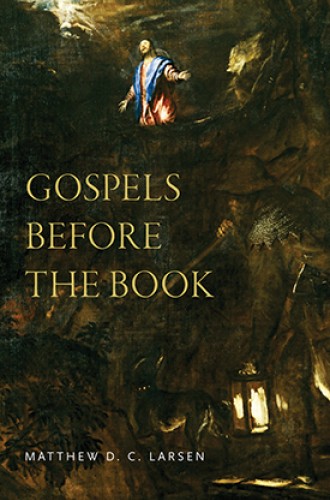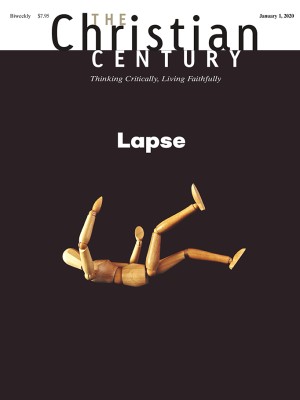Does Matthew correct Mark’s story? Or complete it?
Matthew D. C. Larsen challenges long-held assumptions about the Gospels.
On the first day of New Testament classes, I alert my students: the scriptures emerged in complex circumstances. When they were written, nobody knew how things would turn out. Everything is fluid. Everything is contingent.
According to the familiar model of Gospel origins, Jesus said and did some things, people remembered these words and deeds, and eventually they passed what they remembered along. Invention and adaptation shaped that process until second-generation Christians put their traditions into writing. The four Gospels emerged from those sources, with Mark providing the basis for the Gospels of Matthew and Luke.
Although this conventional model has often been challenged, Matthew Larsen calls for a more thorough revision, relying on evidence that scholars haven’t considered before. In vivid prose, he invites us to imagine how first- and second-century readers (people who didn’t possess bound volumes with spines and covers) would have understood the Gospels. Larsen conjures a world in which people didn’t think of Matthew and Mark as distinct literary works by different authors. Instead, people would have thought of them “as the same open-ended, unfinished, and living work.”
Read our latest issue or browse back issues.
Larsen doesn’t deny the processes of collection and redaction that scholars have long recognized. But he points to a period in which people would have perceived those processes very differently than we do. Had they encountered Mark and Matthew side by side, they would have experienced them as two iterations of the same story. They would not have thought that the author of Matthew took the finished Gospel of Mark, added some details, and corrected Mark for style, theological propriety, and a different readership.
Larsen builds his case gradually. First, through a series of case studies, he shows that many ancient texts do not conform to our notions of finished and authoritative public texts by identifiable authors. He discusses “unfinished and less authored texts” from antiquity: collections of notes and partial compositions, which by design were available for others to complete, polish, and publish. Some such collections were left alone for personal use or as resources for the public record, others served as raw materials for their authors’ more complete works, and others were left for editing and composition by more competent authors. Although these sketchy materials do not correspond directly to the Gospels, Larsen acknowledges, they demonstrate the fluidity of composition and authorship in the ancient world.
He also discusses documents published unintentionally, as when someone steals another’s draft and publishes it or when an admirer takes notes of someone’s speech and publishes that. The result is that multiple versions of a document could exist in the public sphere, some of them far beyond the control of the author. Larsen relates how Cicero agonized over his inability to control his own works.
Larsen also shows that the Dead Sea Scrolls include multiple versions of the Community Rule, indicating variations for every location of the assembly. One copy features an update to the original text but leaves both texts standing side by side. For some texts, no “original” or “authoritative” version ever existed. Multiple versions were commonplace.
The sparks begin to fly when Larsen turns to Mark and Matthew. There was a time before Christians called Mark a Gospel and treated it like a finished publication, Larsen claims, and Matthew emerged in that time period. Matthew handles Mark like a set of collected notes, or hypomnēmata. (So does Papias, a second-century bishop who commented on Mark, according to a particularly incisive analysis on Larsen’s part.)
Using almost all of Mark’s scenes, Matthew adds the components necessary for an ancient biography, including Jesus’ origins and birth, the nature of his teaching, and his fate. The features that most interpreters identify as theologically driven redaction, Larsen argues, instead reflect Matthew’s attempts to lend clarity to Mark’s raw material. The various endings glommed on to Mark perform the same kind of work, bringing closure to an unfinished text. In Larsen’s view it is more correct to say Matthew completes Mark’s story than that Matthew corrects it.
Does this book mark a watershed in Gospel studies, as some scholars have claimed? The reaction to it will likely be polarized, with discussion clustering around two issues.
First, does Larson adequately account for some of the patterned ways in which Matthew adapts Mark? Matthew’s work involves far more than supplementing and clarifying. Matthew adds to Mark layers of overt theological interpretation, such as the dozen or so fulfillment formulas that link aspects of the story to scripture: “Such and such happened in order that the words of the prophet might be fulfilled. . . .”
Second, Larsen reads Mark as hypomnēmata, or unfinished. He begins by describing his project as an experiment in how ancient readers perceived Mark, not as a claim that Mark was originally crafted to be incomplete. But when Larsen spools out his interpretation, which offers a brilliant assessment of Mark’s structure, it looks very much like an argument that Mark’s inconsistencies and tensions result from its being unfinished. He maintains that no one ever tried to “fix” the mixed clues Mark offers regarding Christology, soteriology, and the Messianic Secret because Mark was an unfinished document, useful for preaching and teaching in early Christian assemblies.
Here Larsen directly addresses the underlying tension. Modern scholars have not discovered the literary brilliance they attribute to Mark; they’ve produced it. Their interpretations sprout from anachronistic assumptions about what kind of text Mark is.
The assertion that Mark isn’t a polished narrative would benefit from more argumentation than Larsen gives it. For example, he describes Mark 8:22–10:52 as a unit held together by Jesus being “on the way” to Jerusalem and by the metaphors of seeing that open and close the unit. But he does not discuss how the preceding scene, in which Jesus warns his disciples about the leaven of the Pharisees and the Herodians, also foregrounds seeing without perceiving (8:17–18). Nor does he acknowledge that when Jesus castigates the disciples for failing to perceive (8:17, 21) he employs the same language he had applied to outsiders in Mark 4:10–12. The literary thematics of Mark’s Gospel transcend the “note-like structure” Larsen assigns to it.
Larsen’s model also fails to acknowledge several points at which Matthew underestimates Mark’s literary sophistication. To take one example, Mark’s story of Jesus feeding the five thousand (6:30–44) echoes Psalm 23. Jesus feels compassion for the crowds, who are like “sheep without a shepherd.” He causes them to recline on the “green grass.” The disciples collect 12 baskets of leftovers. (“My cup runneth over”?) Matthew, who routinely prunes Mark’s prose, here excises Mark’s most telling cue: Matthew keeps the reference to the grass but omits mentioning its color, thereby omitting the allusion to the words of the psalm, “He makes me lie down in green pastures.”
Without question, this is an excellent book. Larsen’s writing is crisp, succinct, and evocative. His analysis is fresh and direct. I often find myself wondering, “How’d this guy find all these case studies?”—and every answer I can imagine requires exceptional diligence and ingenuity.
In the end, I suspect the book’s enduring influence will depend upon how we resolve two questions. Has Larsen truly revolutionized how we conceive of redaction? And does Mark make more sense as an incomplete or a complete literary work?
A version of this article appears in the print edition under the title “The Gospels unbound.”






